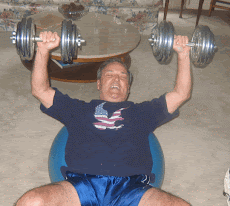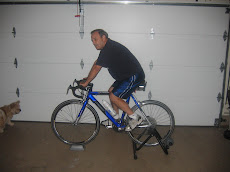Following are the 3 major types of exercise:
1. Weight or resistance training: The general definition of weight or resistance training is any type of exercise that overloads the muscles of the body and causes them, and ligaments and bones as well, to grow stronger, firmer, and fitter. Following are the general types of weight or resistance type training.
a. Barbell and dumbbells weight training exercises
b. Weight training machines
c. Exercises with cables or resistance type rods or bands
d. Body weight exercises
2. Cardio exercises: Any type of exercise that elevates the heart rate, ideally to your target heart rate based on your age and fitness level, see below:
Male:
220-Age (Non-athletic person)
205-Age/2 (Fit person)
Female:
226-Age (Non-athletic)
211-Age/2
Typical types of cardio exercise training include: Fast walking, jogging, running, stair steppers, cross trainers, bike riding, and other sports like tennis, soccer, or lacrosse. Weight training can also be an effective cardio exercise, if done with only a short rest between sets.
3. Flexibility exercises: Any type of exercises like stretching and yoga designed to increase and maintain the body’s flexibility. Flexibility is also important to prevent different type of injuries, and help slow down the aging process. I’ve found that it’s also a key factor in recovery from problems with lower back pain.
What Type of Exercise is BestI feel that all three types of exercise are important for achieving and maintaining maximum health and fitness. The exact type and amount of exercise you choose should be based on a number of individual factors. Following are some things to consider in developing an exercise program that will enable you to achieve your health and fitness goals:
• Do you want to lose weight or fat? If so, how much?
• Do you want to firm up certain body parts? eg. Slimmer waist, flat stomach, firm arms, or six-pack abs etc. to look more attractive.
• Increase the strength and look of certain body parts?
• Improve your overall health?
• Improve your athletic performance in a certain area?
• Avoid aging, and stay younger longer?
• How much time do you have available to exercise? (keep in mind that a lot can be accomplished in relatively short periods of time eg. 15-30 minutes 3-4 times per week)
• Do you have a gym or exercise facilities available to you? (Even if no, there are many effective exercises that can be done in your home or office in a very short period of time with little or no equipment).
Strength TrainingScientific research has clearly shown that the best way to lose fat is strength training. It works for obese people as well as those just wanting to lose a few pounds and firm up. When we strength train, we add lean muscle mass to our body. This lean muscle mass burns through 35-50 calories per pound of muscle every single day.
Let's take a look at that number from a different point of view. If we have 5 pounds of lean muscle, that muscle will burn about 250 calories a day. Here comes the fun part. If we have 10 pounds of lean muscle mass, then our muscles burn about 500 calories a day. Hopefully you can see why adding lean muscle is the best way to lose fat.
If we couple strength training with cardio training and flexibility exercises, you will have a more complete and beneficial exercise routine:
Walking, jogging, and running are probably the most common for of cardio exercises people are doing today. Bike riding, swimming, cross trainers, dancing, or tennis have also gotten pretty popular.
The issue, however, is not so much the particular form of cardio exercise, but the intensity levels and benefits. In order for an exercise to be considered "cardiovascular" or "aerobic," it needs to elevate your heart rate to 60 to 85 percent of its maximum rate (the fastest it could possibly beat). When you're in the aerobic zone, you should be able to talk, but not able to carry on a long conversation.
Cardio Exercise
Cardiovascular exercise has numerous health benefits. In addition to burning calories and lowering your body fat, it will strengthen your heart and lungs.
While many experts feel that cardiovascular training should last for 30 to 60 minutes, recent research has shown that shorter more intense cardio cycles are much more effective at burning fat and improving your lung, heart, and overall cardio capacity and functioning eg. 3-4 minutes of warm up cardio followed by a 2-3 cycles of alternating 2 minutes of intense exercise followed by 2 minute intervals of lower cardio intensity.
Just fifteen to twenty minutes of high intensity interval cardio can increase your aerobic capacity (VO2max) dramatically, maintains lean muscle mass, boosts your metabolism during and after exercise, and burns more fat calories than 45-60 minutes of low intensity cardio.
Sound too good to be true? It’s not. One research study showed participants who engaged in short high intensity training lost 9 times more fat than those who performed long low intensity training.
There are pros and cons to various types of cardio exercises eg. some such as jogging and running may be hard on your knees or lower back, while others may be things that you just do not enjoy doing. The most important thing, however, is to choose a form of cardio exercise that is easily available and something you enjoy doing.
Flexibility Exercises
Regular flexibility exercises like Yoga stretching exercises are also very important to prevent injury, and keep our bodies joints, ligaments, and muscles supple and flexible, especially as we get a little older. It also helps prevent and relieve lower back problems and injuries.
Yoga has been known to prevent muscle soreness and promotes faster recovery between whatever training sessions you give it. Yogic stretching is like a constant battery charger.
It loosens tight muscles, which tend to trap lactic acid, the waste product that accumulates in the muscle cells during other hard training sessions apart from yoga that you may like to partake in.
Increasing flexibility is very important. Yoga also has positions that act upon the whole body including those joints that we never consider exercising.
A body which may have been quite rigid at the beginning of learning a stretching or yoga program will start to experience a remarkable flexibility in all parts, even those parts which have not been consciously worked upon.
Conclusion
While this may at first seem overwhelming to you, it really shouldn’t. It really doesn’t have to take much time, it doesn’t have to be expensive, and it’s not that difficult. And you’ll find that just a few short 15-20 minute exercise sessions per week will pay huge dividends in improved health and fitness.
So if you want to lose weight, firm up, look and feel better, and stay young longer, look for ways to integrate the 3 types of exercise into your regular schedule.



